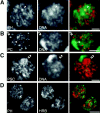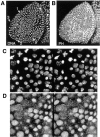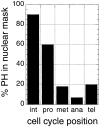The distribution of polycomb-group proteins during cell division and development in Drosophila embryos: impact on models for silencing
- PMID: 9548724
- PMCID: PMC2148446
- DOI: 10.1083/jcb.141.2.469
The distribution of polycomb-group proteins during cell division and development in Drosophila embryos: impact on models for silencing
Abstract
The subcellular three-dimensional distribution of three polycomb-group (PcG) proteins-polycomb, polyhomeotic and posterior sex combs-in fixed whole-mount Drosophila embryos was analyzed by multicolor confocal fluorescence microscopy. All three proteins are localized in complex patterns of 100 or more loci throughout most of the interphase nuclear volume. The rather narrow distribution of the protein intensities in the vast majority of loci argues against a PcG-mediated sequestration of repressed target genes by aggregation into subnuclear domains. In contrast to the case for PEV repression (Csink, A.K., and S. Henikoff. 1996. Nature. 381:529-531), there is a lack of correlation between the occurrence of PcG proteins and high concentrations of DNA, demonstrating that the silenced genes are not targeted to heterochromatic regions within the nucleus. There is a clear distinction between sites of transcription in the nucleus and sites of PcG binding, supporting the assumption that most PcG binding loci are sites of repressive complexes. Although the PcG proteins maintain tissue-specific repression for up to 14 cell generations, the proteins studied here visibly dissociate from the chromatin during mitosis, and disperse into the cytoplasm in a differential manner. Quantitation of the fluorescence intensities in the whole mount embryos demonstrate that the dissociated proteins are present in the cytoplasm. We determined that <2% of PH remains attached to late metaphase and anaphase chromosomes. Each of the three proteins that were studied has a different rate and extent of dissociation at prophase and reassociation at telophase. These observations have important implications for models of the mechanism and maintenance of PcG- mediated gene repression.
Figures






References
-
- Agard D, Hiraoka Y, Shaw P, Sedat J. Fluorescence microscopy in three dimensions. Methods Cell Biol. 1989;30:353–377. - PubMed
-
- Alkema M, Bronk M, Verhoeven E, Otte A, van't Verr L, Berns A, von Lohuizen M. Identification of Bmi1-interacting proteins as constituents of a multimeric mammalian Polycomb complex. Genes Dev. 1997;11:226–240. - PubMed
-
- Allis CD, Waring GL, Mahowald AP. Mass isolation of pole cells from Drosophila melanogaster. . Dev Biol. 1977;56:372–381. - PubMed
-
- Aparicio OM, Billington BI, Gottschling DE. Modifiers of position effect are shared between telomeric and silent mating-type loci in S. cerevisiae. Cell. 1991;66:1279–1287. - PubMed
-
- Belmont AS, Braunfeld MB, Sedat JW, Agard DA. Large-scale chromatin structural domains within mitotic and interphase chromosomes in vivo and in vitro. Chromosoma. 1989;98:129–143. - PubMed
MeSH terms
Substances
LinkOut - more resources
Full Text Sources
Molecular Biology Databases

